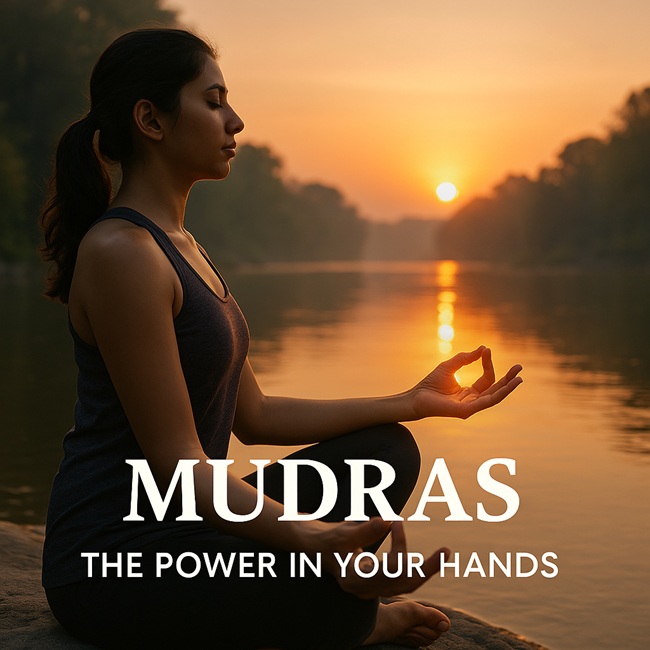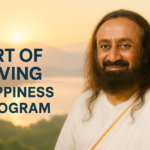If you’ve ever seen someone meditating with their fingers arranged in a specific way, you’ve probably witnessed the silent language of mudras—ancient hand gestures that hold transformative energy.
I stumbled upon mudras during a difficult phase in life when I was exploring yoga, meditation, and healing. What started as curiosity turned into a journey that deeply changed how I look at health, energy, and even stress.
In this blog post, I want to take you through the world of hand mudras, what they are, how to practice them, and how they can help with everything from anxiety and focus to sleep and digestion. Trust me, this isn’t just for yogis—it’s for anyone looking for simple healing practices that are easy to follow and incredibly powerful.

What Are Mudras?
The word “Mudra” in Sanskrit means a gesture or seal. In yogic and Ayurvedic traditions, mudras are symbolic hand gestures believed to channel the flow of energy (prana) in the body and mind.
Each finger represents one of the five elements:
- Thumb – Fire (Agni)
- Index finger – Air (Vayu)
- Middle finger – Space (Aakash)
- Ring finger – Earth (Prithvi)
- Little finger – Water (Jal)
By joining, pressing, or positioning the fingers in specific ways, mudras help restore balance between these elements, bringing physical, mental, and emotional harmony.
9 Powerful Hand Mudras Everyone Should Try
1. Gyan Mudra (Mudra of Knowledge)
What it is: Touch the tip of the thumb to the tip of the index finger. Keep the other three fingers extended.
Benefits:
- Improves concentration and memory
- Enhances focus and clarity
- Calms the mind—great for students and professionals
Best time to do:
Early morning during meditation or before studying/working

How long:
10–30 minutes daily
2. Prana Mudra (Mudra of Life)
What it is: Touch the tips of the ring finger and little finger to the thumb tip. Keep index and middle fingers straight.
Benefits:
- Boosts energy and vitality
- Improves immunity and reduces fatigue
- Helps those feeling low or drained

Best time to do:
Anytime you feel tired or energy-deficient
How long:
15–30 minutes, or in 3 sets of 10 minutes each
3. Vayu Mudra (Mudra of Air)
What it is: Fold the index finger and press it gently with the base of the thumb. Keep the other fingers straight.
Benefits:
- Relieves joint pain, arthritis, sciatica, and gas-related issues
- Calms hyperactivity or restlessness
Best time to do:
Early morning on an empty stomach

How long:
15–20 minutes
Note: Avoid overdoing it; not for those with Vata imbalance
4. Apan Mudra (Mudra of Digestion & Detox)
What it is: Join the tips of the middle and ring fingers to the thumb. Other fingers stay extended.
Benefits:
- Helps with digestion and detoxification
- Eases constipation and bloating
- Balances the excretory system

Best time to do:
After meals or early morning
How long:
15–45 minutes daily
5. Surya Mudra (Mudra of Weight Loss)
What it is: Fold the ring finger and press it with the thumb. Other fingers straight.
Benefits:
- Boosts metabolism
- Supports weight loss
- Balances the thyroid and reduces sluggishness

Best time to do:
Morning, especially during sunrise
How long:
15–30 minutes daily
6. Varun Mudra (Mudra of Water)
What it is: Touch the tip of the little finger to the thumb tip. Keep the rest of the fingers extended.
Benefits:
- Improves skin hydration and glow
- Eases dryness, skin conditions, and joint stiffness

Best time to do:
Anytime during the day
How long:
15–20 minutes
Note: Avoid if you suffer from water retention
7. Shunya Mudra (Mudra of Space/Emptiness)
What it is: Fold the middle finger and press it with the thumb. Keep other fingers straight.
Benefits:
- Helps with ear pain and hearing issues
- Relieves motion sickness and vertigo

Best time to do:
When needed, especially if experiencing ear discomfort
How long:
5–10 minutes
8. Apan Vayu Mudra (Mudra for Heart Health)
What it is: Touch the tip of the thumb with middle and ring fingers. Fold the index finger to touch the base of the thumb. Little finger stays straight.
Benefits:
- Supports heart health
- Acts like a natural first-aid during heart discomfort
- Reduces anxiety and high blood pressure

Best time to do:
Morning or anytime during stress
How long:
15–30 minutes
9. Dhyana Mudra (Mudra of Meditation)
What it is: Place both hands on your lap, right hand over the left, thumbs touching lightly forming a triangle.
Benefits:
- Induces deep meditation
- Brings emotional balance and inner peace
- Encourages spiritual awakening

Best time to do:
During meditation or quiet time
How long:
As long as you meditate
How to Practice Mudras: Quick Guidelines
- Sit comfortably in Sukhasana (easy pose) or on a chair with a straight spine
- Relax your hands on your thighs or knees
- Practice with a calm mind and slow breathing
- Keep eyes closed for better concentration
- No pressure – gentle touch is enough
- You can combine with chanting, meditation, or breathing exercises
When Should You Do Mudras?
| Goal | Time of Day |
|---|---|
| Energy & immunity | Morning (Prana, Surya Mudra) |
| Digestion & detox | After meals or early morning (Apan Mudra) |
| Focus & learning | Before work or study (Gyan Mudra) |
| Stress relief | Evening or during anxiety (Apan Vayu, Dhyana Mudra) |
| Meditation | Sunrise or sunset (Dhyana Mudra, Varun Mudra) |
Ideally, avoid practicing mudras just after eating a heavy meal.
Are There Any Side Effects?
Mudras are generally safe and natural, but here are a few tips:
- Avoid over-practicing any one mudra
- Drink water before and after long sessions
- If you have a medical condition, consult a yoga therapist or doctor
Final Thoughts: Healing Is in Your Hands
When I began practicing mudras, I didn’t expect much. But over time, I noticed:
- Less anxiety
- Better sleep
- Improved digestion
- A surprising sense of balance
You don’t need fancy mats or equipment—just your fingers, some time, and intention. These simple gestures connect us to ancient wisdom that’s still very relevant in today’s chaotic world.
If you’re someone who believes healing should be simple and accessible, start with 10 minutes a day. Choose one mudra that speaks to you and just begin.
Frequently Asked Questions (FAQs) About Mudras
Q1. What are mudras and how do they actually work?
Answer:
Mudras are hand gestures or symbolic finger positions used in yoga, meditation, and Ayurveda to channel energy within the body. Each finger is linked to a specific element (fire, air, space, earth, water). When certain fingers touch or press against each other, it creates a “circuit” of energy that helps restore physical, mental, and emotional balance. They’re like a subtle form of energy therapy—easy to practice but powerful in their effects.
Q2. Do mudras really have scientific benefits?
Answer:
While modern science is still exploring the full depth of mudras, several studies and anecdotal reports support their benefits in reducing stress, improving focus, calming the nervous system, and aiding specific health issues (like digestion or insomnia). They’re often used alongside breathwork and meditation, where the combined effects are even more noticeable. In traditional systems like yoga and Ayurveda, mudras are considered a vital part of self-healing.
Q3. How long should I practice a mudra to see results?
Answer:
The general recommendation is 15 to 30 minutes daily for each mudra. Some people notice results in just a few days, especially with calming or energizing mudras like Gyan Mudra or Prana Mudra. However, consistency is key. Practicing for at least 21 to 40 days can bring noticeable changes in areas like digestion, immunity, mood, or sleep patterns.
Q4. Can I do more than one mudra in a day?
Answer:
Yes, absolutely! You can practice 2 to 3 different mudras in a single day, depending on your needs. For example:
- Start your morning with Prana Mudra for energy
- Use Apan Mudra after meals for digestion
- End the day with Dhyana Mudra for calm and better sleep
Just make sure you give at least 10–15 minutes to each, and listen to how your body responds.
Q5. Can anyone practice mudras? Are there age limits?
Answer:
Yes, mudras are safe for all age groups—children, adults, and even elderly individuals. They are gentle, non-invasive, and require no physical strain. Kids can benefit from focus-improving mudras like Gyan Mudra, while seniors often find relief with Vayu Mudra or Apan Vayu Mudra for joint or heart health.
Q6. Do mudras have any side effects?
Answer:
Generally, mudras are very safe when done in moderation. However:
- Don’t overdo any mudra unless recommended by a therapist.
- People with specific imbalances (like excess heat or water retention) should avoid certain mudras.
- Always stay relaxed while practicing—don’t apply too much pressure with your fingers.
If you’re unsure, consult a certified yoga therapist or Ayurvedic doctor for guidance.
Q7. Can mudras cure diseases?
Answer:
Mudras are not a substitute for medical treatment, but they can be powerful supportive practices. Think of them as part of a holistic lifestyle—like diet, exercise, meditation, and medicine all working together. Mudras help manage symptoms, reduce stress, and speed up healing, especially in chronic conditions or lifestyle-related issues.
Q8. Do I need to sit cross-legged to practice mudras?
Answer:
Not at all! While sitting in Sukhasana (easy pose) or Padmasana (lotus pose) is traditional, you can also practice mudras:
- While sitting on a chair
- Lying down (for some mudras like Varun Mudra)
- During meditation
- Even while walking or working (with focus)
Just try to keep your spine straight and be mindful while practicing.
Q9. When is the best time to practice mudras?
Answer:
Here’s a quick guide:
| Mudra Type | Best Time to Practice |
|---|---|
| Energizing (Prana, Surya) | Morning, on an empty stomach |
| Calming (Gyan, Dhyana) | Early morning or before bed |
| Healing (Vayu, Apan) | After meals or as needed |
| Meditative (Shunya, Dhyana) | During meditation or quiet time |
Consistency matters more than timing. Choose a time that works for you and stick with it.
Q10. Can I do mudras while watching TV or on the phone?
Answer:
Technically yes, but it’s not ideal. Mudras work best when you’re mentally present and focused. Doing them while distracted can reduce their benefits. Try setting aside 10 minutes of quiet time daily—it can make a world of difference.

Hi, I’m Prashant Jain — a curious soul, storyteller, and content creator at heart.I’ve always been drawn to the world of entertainment, travel, sports, health & lifestyle — not just as a writer, but as someone who genuinely lives these experiences. Whether I’m binge-watching the latest OTT series, exploring offbeat spiritual destinations in India, or diving deep into wellness routines and cricket match insights, I love sharing what I discover with like-minded readers.
PopNewsBlend is my way of blending personal journeys with meaningful stories — ones that inform, inspire, and keep you ahead of the curve. Everything I write comes from real observations, hands-on experiences, and a deep passion for understanding the world around us.
Discover more from Popnewsblend
Subscribe to get the latest posts sent to your email.








Pingback: 21 Hindu Mantras For Life Meaning That Reveal the True Meaning of Life